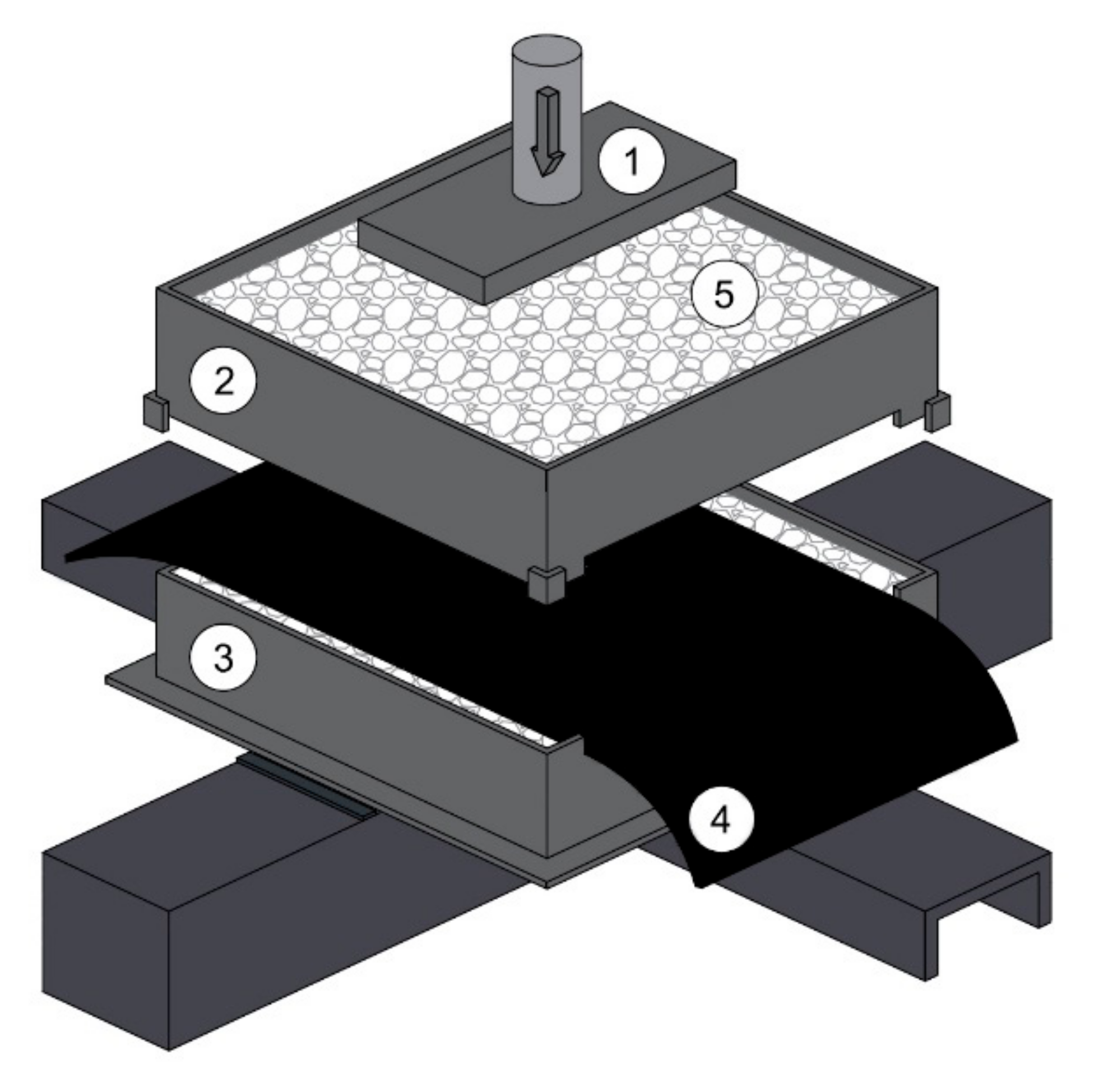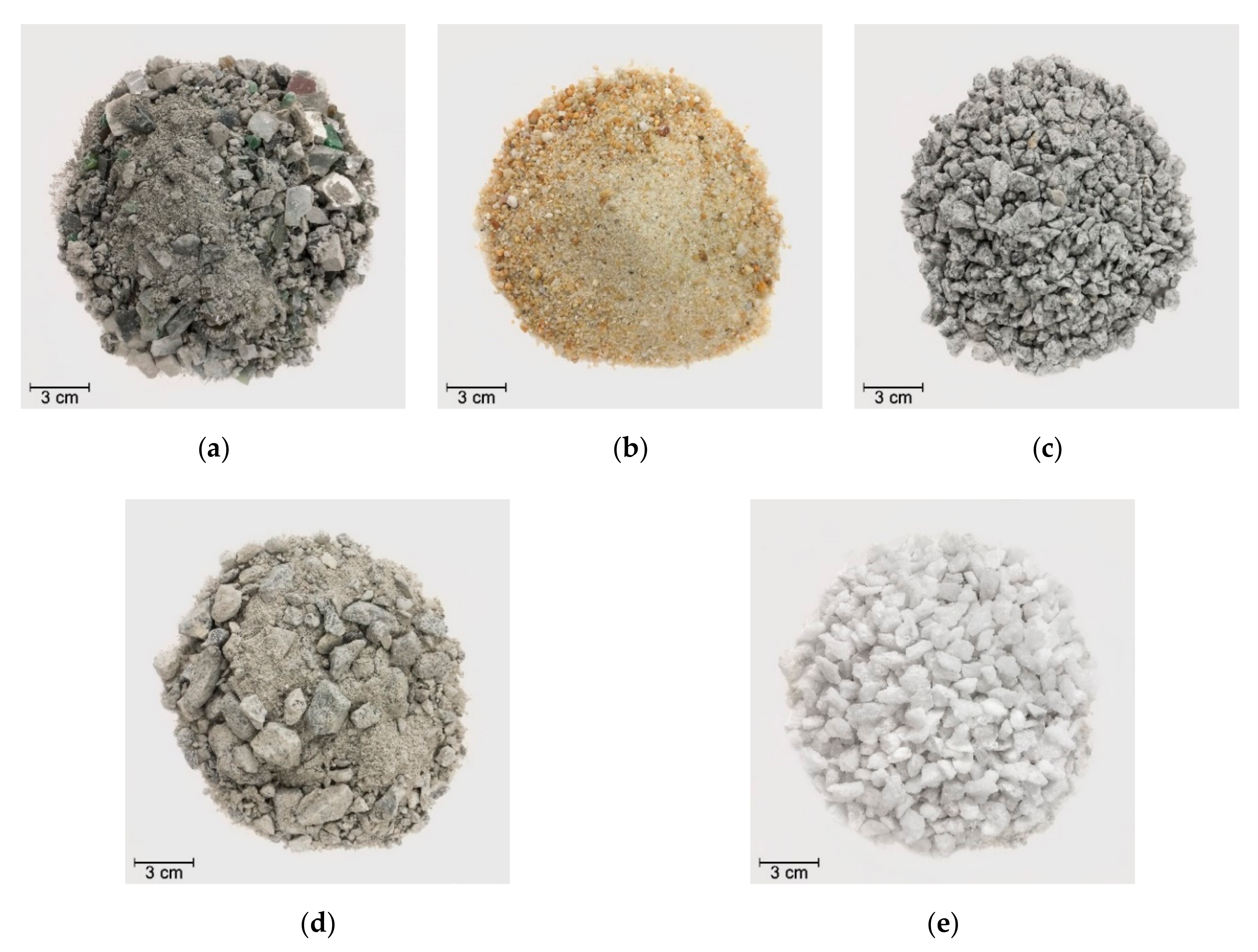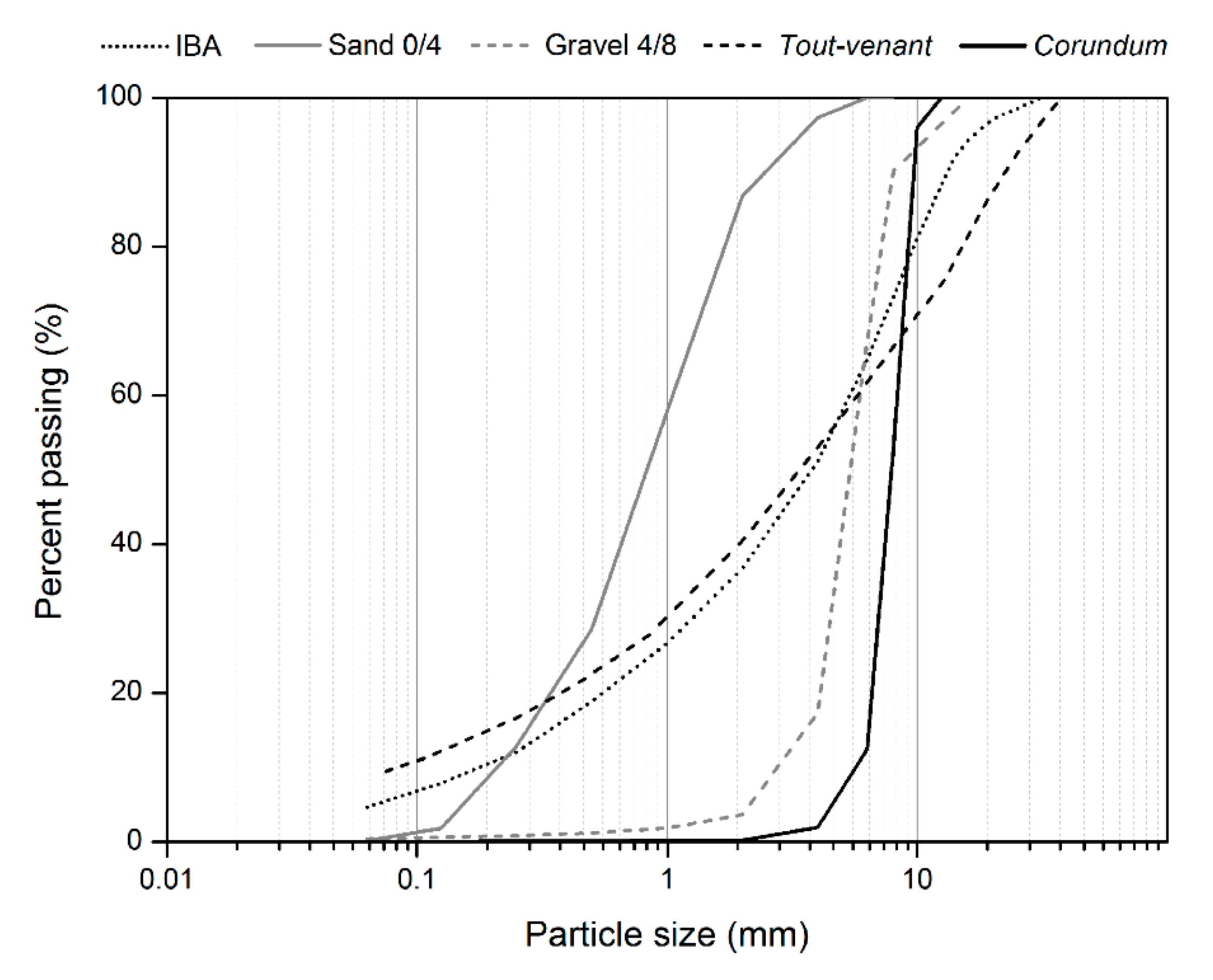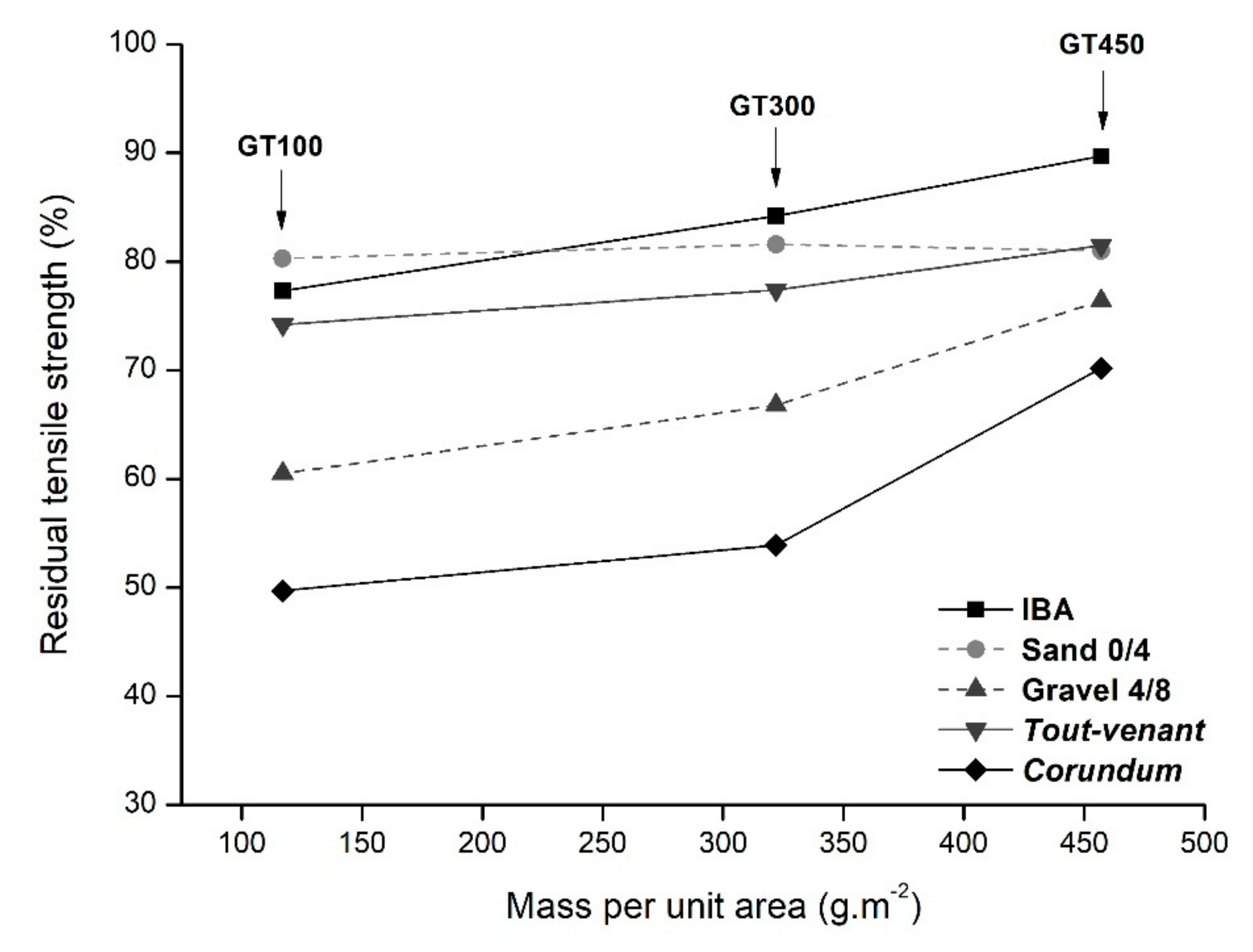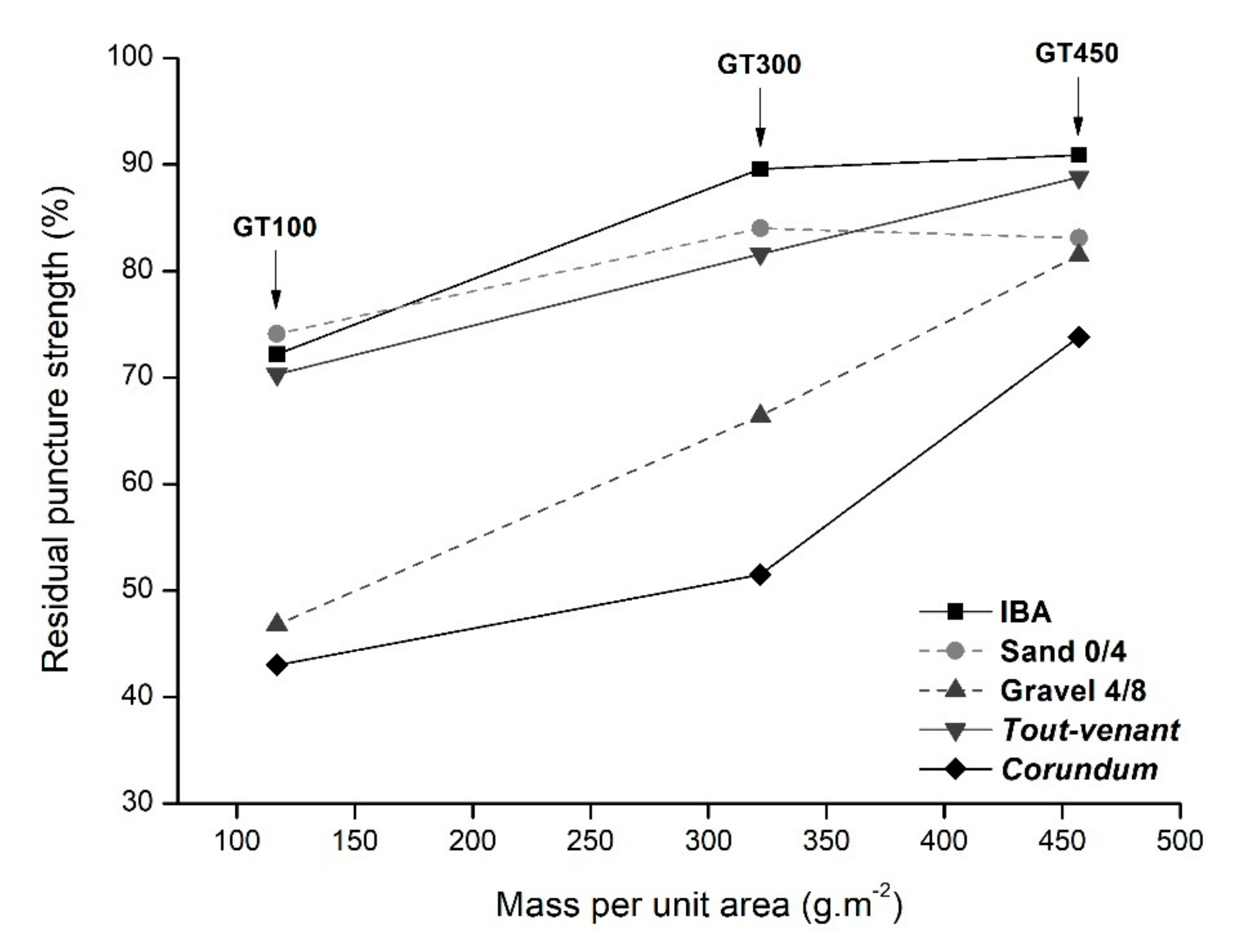1. Introduction
Environment, economy and society are the three dimensions that make up the universal purpose known as Sustainable Development. The quality of life of current and upcoming generations depends on how consistent the measures that are being implemented in terms of environmental policies are. In the European Union, Directive 2008/98/EC [
1] establishes key measures regarding the protection of the environment and human health. The success of environmental policies cannot be assigned to a particular person or institution but to several agents that comprise our society, particularly legislators, researchers, and manufacturers, who should be responsible for involving the population in the overall process.
Actions should be carried out to avoid unreasonable exploitation of natural resources and consumption of energy, which are overwhelming the sustainability and health of planet Earth. Circular economy emerged as a model that aims to extend the lifetime of products, materials and resources, and to reduce the generation of waste. For that purpose, solutions should be developed to promote the reuse and recycling of products and materials, which lead to the reduction, for instance, of incineration and/or landfilling. In addition, efforts should be carried out to understand how residues that are generated can be introduced into valorization chains, in which they could be labelled as raw materials.
Incinerator bottom ash (IBA) is a residue that results from the incineration of municipal solid waste. According to Blasenbauer et al. [
2], there are 463 municipal solid waste incineration plants currently functioning in the European Union, Norway, and Switzerland, leading to the generation of 17.6 megatons of IBA per year. Considering the large amount of IBA that is produced, and in order to prevent its landfilling, there is a need to develop innovative solutions in which IBA plays the role of a noble raw material. The academic community has started on this path, since different investigations have been carried out to find useful roles for IBA, namely: (1) its use in cementitious materials, (2) as a recycled aggregate, or (3) in geotechnical projects. Due to its chemical composition, IBA has been the subject of research aiming to develop alternative cementitious materials to ordinary Portland cement [
3,
4,
5,
6]. In the domain of concrete, IBA showed potential to be used as a recycled aggregate to replace natural aggregates [
7,
8,
9]. Regarding the geotechnics field, IBA was evaluated as a raw material in road construction, where it was used in asphalt concrete or in cement-bound mixtures [
10], and it was also studied as an aggregate in road pavements [
11,
12,
13]. In the latter example, IBA may have contact with geosynthetics. Despite the encouraging findings of the previous works, the environmental behavior of IBA must be deeply studied in order to understand its suitability for being introduced into innovative solutions. Indeed, it is crucial to ensure that IBA does not contain hazardous substances that can be released into soil or water.
Geosynthetics are construction materials that can perform many different functions, e.g., reinforcement, protection, separation, drainage, filtration, erosion control or fluid barrier. This high versatility, associated with their high efficiency, low cost and ease of installation, provides the possibility of using these materials in a wide range of engineering projects such as embankments, roadways, railways, landfill sites or coastal protection structures. Within the framework of geotechnical engineering structures, in which IBA may be used as a filling material (for example, in roadways or railways), geotextiles (one of the main types of geosynthetics) can be suitable construction materials to perform the functions of protection, filtration or separation.
Installation on site may cause damage to geosynthetics, resulting in undesirable changes to their mechanical and/or hydraulic properties. The damage that occurs during the installation process (for example, cuts in components, tears, formation of holes or abrasion) is essentially caused by handling the geosynthetics and by the placement and compaction of filling materials over them. In some cases, the stresses induced during the installation process can be higher than those considered in the design for service conditions [
14].
Mechanical damage is often associated with the installation process of geosynthetics. In order to induce mechanical damage to geosynthetics, the European Committee for Standardization developed a standard method (EN ISO 10722 [
15]). This method has been used by some authors to evaluate the damage that occurs during the installation of geosynthetics [
16,
17], while others tried to correlate it with field installation conditions [
18,
19]. The evaluation of installation damage can also be carried out by field tests, which provide more reliable data about the behavior of geosynthetics. However, these tests are more expensive and time-consuming and require the use of heavy equipment and skilled workers, making them unsuitable for routine analysis. Damage assessment is usually carried out by monitoring changes in the mechanical behavior of geosynthetics [
20,
21,
22]. Some authors have also monitored changes in their hydraulic behavior [
23,
24,
25].
Filling materials (which can come into contact with geosynthetics in many applications) are often natural and may, in some cases, be replaced by recycled aggregates. When considering the use of recycled aggregates in applications where they will be in contact with geosynthetics, it is expected that the recycled aggregates do not cause higher mechanical damage to these construction materials, compared with the natural aggregates commonly used. Existing studies about the use of recycled aggregates in contact with geosynthetics are relatively few. Vieira and Pereira [
26] and Vieira et al. [
27] developed investigations in which the interface properties between recycled aggregates resulting from construction and demolition waste and geosynthetics were studied. The mechanical damage induced to geosynthetics by recycled aggregates resulting from the previously mentioned waste stream was also addressed, namely by Vieira and Pereira [
28] and Carlos et al. [
29], whose findings offered positive perspectives when it came to exploiting the use of recycled aggregates in applications involving contact with geosynthetics.
Similar to other recycled aggregates, one relevant aspect that has to be evaluated when considering the possibility of using IBA as a filling material in contact with geosynthetics is the degree of mechanical damage induced by IBA to those construction materials. If the outcomes are positive, a door is opened to using IBA in this particular application, which would contribute to promoting more environmentally friendly practices towards a circular economy in the domain of geotechnical engineering.
In this work, three nonwoven geotextiles were submitted to laboratory mechanical damage under repeated loading tests with IBA and also, for comparison purposes, three natural aggregates (sand 0/4, gravel 4/8 and tout-venant) and a standard aggregate (corundum). The changes that occurred in the short-term tensile and puncture behaviors of the geotextiles were monitored. The main goals of the work included: (1) evaluation of the effect of IBA on geotextiles, (2) comparison between the damage induced by IBA and by the natural and standard aggregates, and (3) evaluation of whether IBA can be a viable alternative as a filling material in replacement of natural aggregates (in terms of mechanical damage induced on the geotextiles).
3. Results and Discussion
3.1. Geotextile GT100
The MD tests affected GT100 distinctively, depending on the aggregate. Tests with sand 0/4,
tout-venant and IBA induced practically no visible damage to the nonwoven structure, only some minor abrasion on the contact surfaces between the geotextile and the aggregates. On the other hand, gravel 4/8 and
corundum provoked visible damage in GT100 like some small cuts, punctures and abrasion (the damage caused by
corundum appeared to have been slightly higher than that induced by gravel 4/8). In all cases, it was possible to find some fine particles (constituent particles of the aggregates or particles resulting from their fragmentation during the MD tests) imprisoned in the nonwoven structure. The mechanical properties of GT100, before and after the MD tests, can be found in
Table 3.
Contrary to what was expected, the MD tests with sand 0/4, tout-venant and IBA (aggregates that apparently did not induce relevant damage) caused reductions (between 19.7% and 25.8%) in the T of GT100 (the decrease was slightly more pronounced after the MD tests with tout-venant). These results indicated that, although not visibly detectable, the MD tests induced some physical damage on the nonwoven structure.
Like the previous aggregates, gravel 4/8 and corundum also provoked reductions in T, but these were much more pronounced (39.5% and 50.3%, respectively). These reductions were, once again, much more significant than those expected, taking into account the damage visibly found in GT100. Yet, as expected from visual analysis, the MD tests with gravel 4/8 were less damaging than the MD tests with corundum.
Similar to
T,
EML also suffered some changes (
Table 3). The highest reductions in
EML occurred after the MD tests with gravel 4/8 and
corundum (reductions from 48.4% to 29.1% and to 28.6%, respectively). Like the losses in
T, the reductions in
EML after the MD tests with sand 0/4,
tout-venant and IBA were relatively similar and lower than the reductions induced by gravel 4/8 and
corundum.
The puncture properties of GT100 also suffered relevant changes after the MD tests (
Table 3). These changes depended, once again, on the characteristics of the aggregates. Like
T,
FP experienced pronounced losses after the MD tests with gravel 4/8 and
corundum (53.2% and 57.0%, respectively). The reductions provoked by sand 0/4,
tout-venant and IBA were identical (between 25.9% and 29.7%) and significantly lower than those caused by gravel 4/8 and
corundum. Besides the losses in
FP, reductions also occurred in
hP (reduction trend not as evident as that found for
FP). It should be highlighted that the reductions in
FP were slightly more pronounced than those that occurred in
T.
3.2. Geotextile GT300
The tests with sand 0/4,
tout-venant and IBA did not lead to visible damage in GT300. On the other hand, the tests with gravel 4/8 and
corundum induced minor visible damage, namely small punctures and some abrasion. Like for GT100, the damage caused by gravel 4/8 seemed to be slightly less than the damage provoked by
corundum. In all cases, and like before, fine particles were found imprisoned in the nonwoven structure. The tensile and puncture properties of GT300 can be found in
Table 4.
As observed in GT100, the MD tests with sand 0/4,
tout-venant and IBA also induced reductions in the
T of GT300. These reductions were relatively similar (between 15.8% and 22.6%) but more pronounced than those expected from the apparent non-existence of relevant physical damage on the geotextile. The losses provoked by the MD tests with gravel 4/8 and
corundum (33.6% and 48.5%, respectively) were significantly more pronounced than those caused by sand 0/4,
tout-venant and IBA. The trend observed in the variation of
EML was, in general, identical to the trend found in
T (
Table 4).
Losses that occurred in FP were relatively identical to those observed in T (comparing the same MD tests). For example, the MD tests with IBA induced, respectively, reductions of 15.8% and 10.4% in the T and FP of GT300. The same trend was observed for gravel 4/8 (there were reductions of 33.2% and 33.6%, respectively) and corundum (with reductions of 46.1% and 48.5%, respectively). The hP also decreased after the MD tests (again, the reduction trend was not as evident as that found for FP).
Resistance losses that occurred after the MD tests were more pronounced for GT100 than for GT300, particularly regarding FP. This indicates that the mass per unit area influences the degree of degradation of the geotextiles in MD tests (there was better survivability for the geotextile with a higher mass per unit area).
3.3. Geotextile GT450
Similar to what was observed for GT300, only minor defects (such as small punctures and abrasion) were detected in GT450 after MD tests with gravel 4/8 and
corundum. The tests with IBA, sand 0/4 and
tout-venant did not cause detectable damage. The results obtained for the tensile and puncture properties of GT450 are exhibited in
Table 5.
The behavior of GT450 after the MD tests was relatively identical to the behavior of GT100 and GT300, leading to analogous conclusions. However, reductions that occurred in its T and FP tended to be less pronounced than those observed in GT100 and GT300. For example, the MD tests with IBA led to reductions in T of 22.7%, 15.8% and 10.3% in GT100, GT300 and GT450, respectively. It is worth mentioning that the losses that occurred in the T of GT450 tended to be slightly higher than those found in FP. The higher resistance of GT450 (compared with the other geotextiles) shows, once again, that the increase of mass per unit area resulted in a better performance with regard to the MD tests.
3.4. Comparison of the Effect of the Aggregates
The effect of the different aggregates was compared by the impact that they caused on the tensile and puncture properties of the geotextiles. Comparison of the
TResidual of the geotextiles after MD tests can be found in
Figure 4.
Figure 5 illustrates a similar comparison for
FP Residual. It is worth mentioning that the points representing the residual strengths of the geotextiles in
Figure 4 and
Figure 5 were joined by lines in order to highlight the effect of mass per unit area on the resistance of the geotextiles against mechanical damage.
The MD tests with sand 0/4 led to some reductions in the T of the geotextiles (the TResidual was between 80.3% and 81.6%). Regarding the effect on FP, GT100 was slightly more affected (there was a reduction of 25.9%) than GT300 and GT450 (with reductions of 16.0% and 16.9%, respectively). Compared with the other aggregates, sand 0/4 was one of the less damaging. The geometry and dimensions of this aggregate (D10, D50 and D60 of, respectively, 0.20, 0.86 and 1.07 mm) fostered the formation of a plane and regular surface after compaction. Therefore, there was a high contact surface area between sand 0/4 and the geotextiles, which could have contributed to a good distribution of the applied loads (and, thus, would have minimized the occurrence of damage). However, as a consequence of the non-cohesive nature of sand 0/4, considerable settlements occurred during the MD tests, which affected the aforementioned good distribution of the applied loads. Even though the particles were of low dimensions, they had a rough texture, which may have induced some damage (not very pronounced nor visibly detected) on the nonwoven structures (which explains the relatively minor deterioration of the mechanical properties of the geotextiles).
As sand 0/4, tout-venant also did not provoke extensive degradation in the geotextiles. The lower degradation caused by tout-venant (when comparing with gravel 4/8 or corundum) may be related to its well graded classification. Indeed, despite having the highest DMax (31.5 mm), tout-venant had a relatively high percentage of fine particles (8.0% of the particles had a particle size lower than 0.063 mm) and a low quantity of larger particles compared with other aggregates (for example, the D50 of tout-venant was lower than the D50 of gravel 4/8 or corundum). Hence, tout-venant originated in a fairly flat and smooth surface when compacted (the particles of lower dimensions were surrounding their counterparts of higher dimensions and thereby fulfilling the voids), thus creating a large contact area with the geotextiles and allowing for better distribution of the applied loads. Yet, the particles of higher dimensions with angular shape were capable of inducing some damage to the geotextiles.
The MD tests with gravel 4/8 provoked pronounced losses in the mechanical resistance of the geotextiles. Gravel 4/8 was a poorly graded aggregate (D10, D50 and DMax of, respectively, 2.92, 5.79 and 8.0 mm) formed by rough particles with angular shape, which explains it being the natural aggregate that caused the highest reductions in the T and FP of the geotextiles.
The reductions in resistance imposed by the natural aggregates were lower compared with
corundum, which was a poorly graded synthetic aggregate (
D10,
D50 and
DMax of, respectively, 5.77, 7.91 and 10.0 mm). In addition, the particles forming
corundum had an angular shape (which can promote cuts in the nonwoven structures), were rough and had a high abrasive effect (the abrasive effect of
corundum was noticeably higher than the other aggregates). Therefore, the use of
corundum in EN ISO 10722 [
15] seems to establish a conservative approach to evaluating the mechanical damage suffered by geotextiles. Indeed, all natural aggregates induced lower reductions in the resistance of the geotextiles than those caused by
corundum. The execution of field tests (with the same natural aggregates and geotextiles), and further comparison with laboratory results, may allow reliable conclusions about the suitability of
corundum (and the MD test described in EN ISO 10722 [
15]) in simulating field installation conditions.
Finally, the effects of IBA were identical to the effects of sand 0/4 and slightly less pronounced compared with
tout-venant. The particle size distribution of IBA and
tout-venant were much identical (
Figure 3), which explains the similarities between the effects of these aggregates on the mechanical properties of the geotextiles. Indeed, despite having different
DMax (higher for
tout-venant), the
D30,
D50 and
D60 of IBA and
tout-venant were not significantly different. As
tout-venant, IBA also had a relatively high number of fine particles (when compared with sand 0/4, gravel 4/8 or
corundum), which surrounded the larger particles and originated a relatively plane and regular surface for the transference of stresses during the MD tests. Although IBA had a higher
DMax than gravel 4/8 and
corundum (14.0 mm for IBA and, respectively, 8.0 and 10.0 mm for gravel 4/8 and
corundum),
D60, D
50,
D30 and
D10 were lower compared with those aggregates. This circumstance also contributes to the lower degradation induced by IBA to the geotextiles when compared with gravel 4/8 or
corundum. The damaging effect of IBA may be ascribed to the presence of some cutting materials in its composition (such as glass, metals and ceramic waste), which may have induced some cuts (not detected by naked eye) on the geotextiles.
The behavior of IBA was very promising for the possible use of this recycled aggregate as a filling material that comes into contact with geotextiles. For instance, in embankment projects, the substitution of local soils with soils with proper properties is a common practice when they are not in compliance with demanded requirements. This procedure implies removing soils from their original location, leading to negative environmental impacts. Another solution is the potential use of IBA as a replacement of tout-venant in the construction of transport infrastructures, since they have similar particle size distributions. If IBA meets the requirements to be considered as a recycled aggregate that can be used in place of natural aggregates in engineering projects, steps are being taken towards more environmentally friendly practices within this domain.
4. Conclusions
MD tests with IBA caused some deterioration of the tensile and puncture properties of three nonwoven geotextiles. However, the damage caused by IBA was not that different (in some cases, even lower) to the damage induced by sand 0/4 or by tout-venant (two natural aggregates). When compared with gravel 4/8 (another natural aggregate) and corundum (a synthetic aggregate used in the standard method for inducing mechanical damage on geosynthetics), the effect of IBA on the mechanical behavior of the geotextiles was significantly less pronounced.
Regarding the possibility of using IBA as a filling material in contact with geotextiles (and/or other geosynthetics), this research does not allow definitive conclusions, since it only evaluated the mechanical damage induced by that recycled aggregate on geotextiles. Still, and as previously stated, the effect of IBA on the short-term mechanical behavior of the geotextiles tended to be less pronounced than (or, at least, identical to) the effects of natural aggregates or the effects of corundum. These results open good potential for using IBA as a filling material that comes into contact with geotextiles. However, before assigning this role to IBA, field damage tests should be carried out to verify if the conclusions obtained in the laboratory effectively represent the behavior of the geotextiles under real conditions.
Even if IBA shows positive behavior in terms of the mechanical damage induced to the geotextiles, additional studies are required before its application as a filling material is carried out. Indeed, it is also important to evaluate the effects of IBA on the long-term behavior of geotextiles. The use of alternative filling materials, like IBA, may also address environmental concerns (for example, the possible contamination of soils and water). Therefore, the characterization of the chemical composition of IBA and the performance of leachate tests may help in assessing the potential amounts of hazardous substances that could be released into the environment. It is also important to evaluate if IBA meets the requirements established for the use of recycled aggregates in the domain of geotechnical applications.
Current circumstances require the development of solutions including the reuse and recycling of residues. Considering the interesting performance exhibited by IBA in this research, it seems reasonable to recognize its potential use as a filling material that comes into contact with geotextiles, allowing for its valorization and thereby contributing to more sustainable solutions within engineering applications.

